Electronic-Waste (E-Waste) Recycling
VerifiedAdded on 2023/05/30
|8
|1685
|194
AI Summary
This article discusses the importance of electronic waste (e-waste) recycling and its benefits to the environment, economy, and society. It highlights the need for proper e-waste disposal to avoid possible harm to the environment and the exposure of sensitive information to unauthorized parties. The article also explains how e-waste recycling helps to limit the exploitation of natural resources and generate income for the country.
Contribute Materials
Your contribution can guide someone’s learning journey. Share your
documents today.
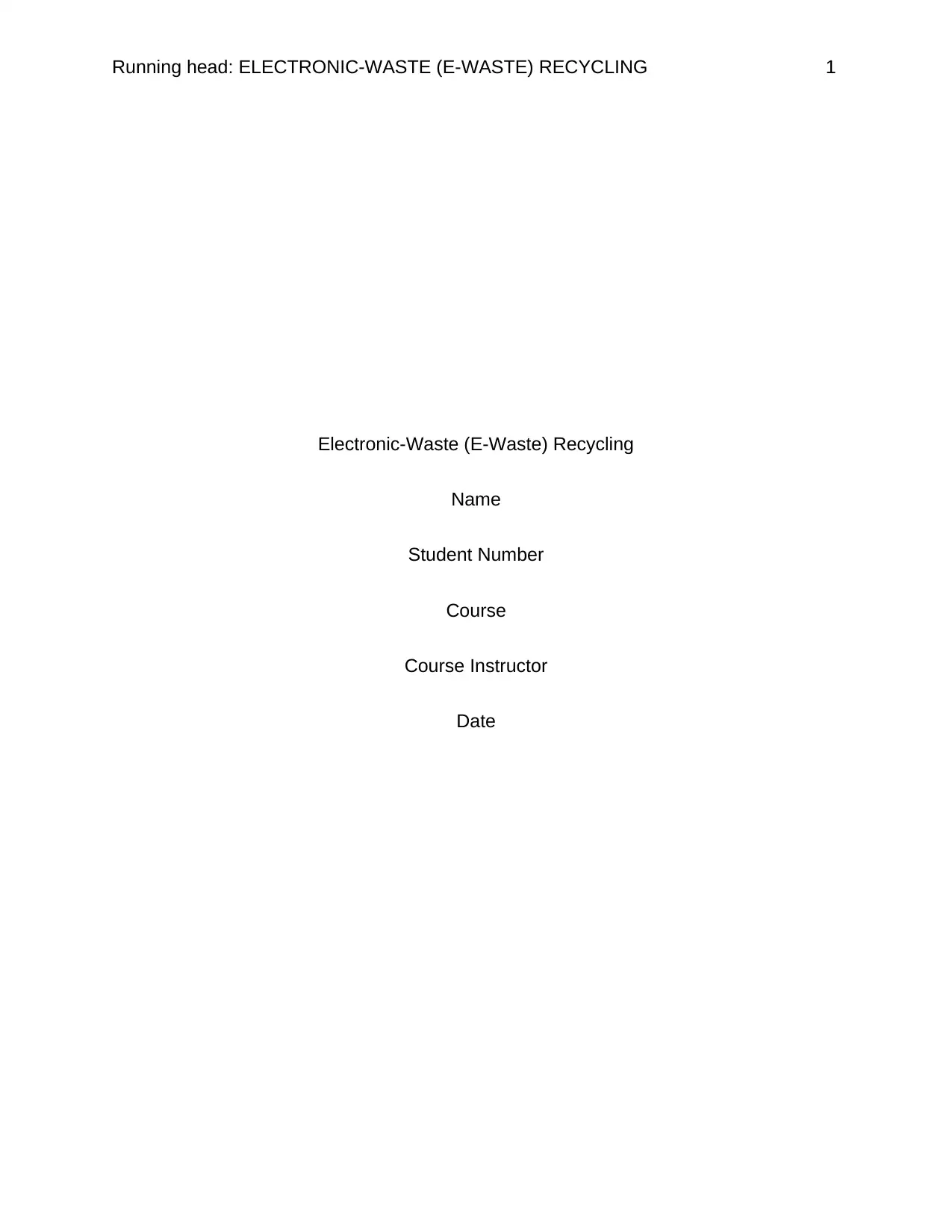
Running head: ELECTRONIC-WASTE (E-WASTE) RECYCLING 1
Electronic-Waste (E-Waste) Recycling
Name
Student Number
Course
Course Instructor
Date
Electronic-Waste (E-Waste) Recycling
Name
Student Number
Course
Course Instructor
Date
Secure Best Marks with AI Grader
Need help grading? Try our AI Grader for instant feedback on your assignments.
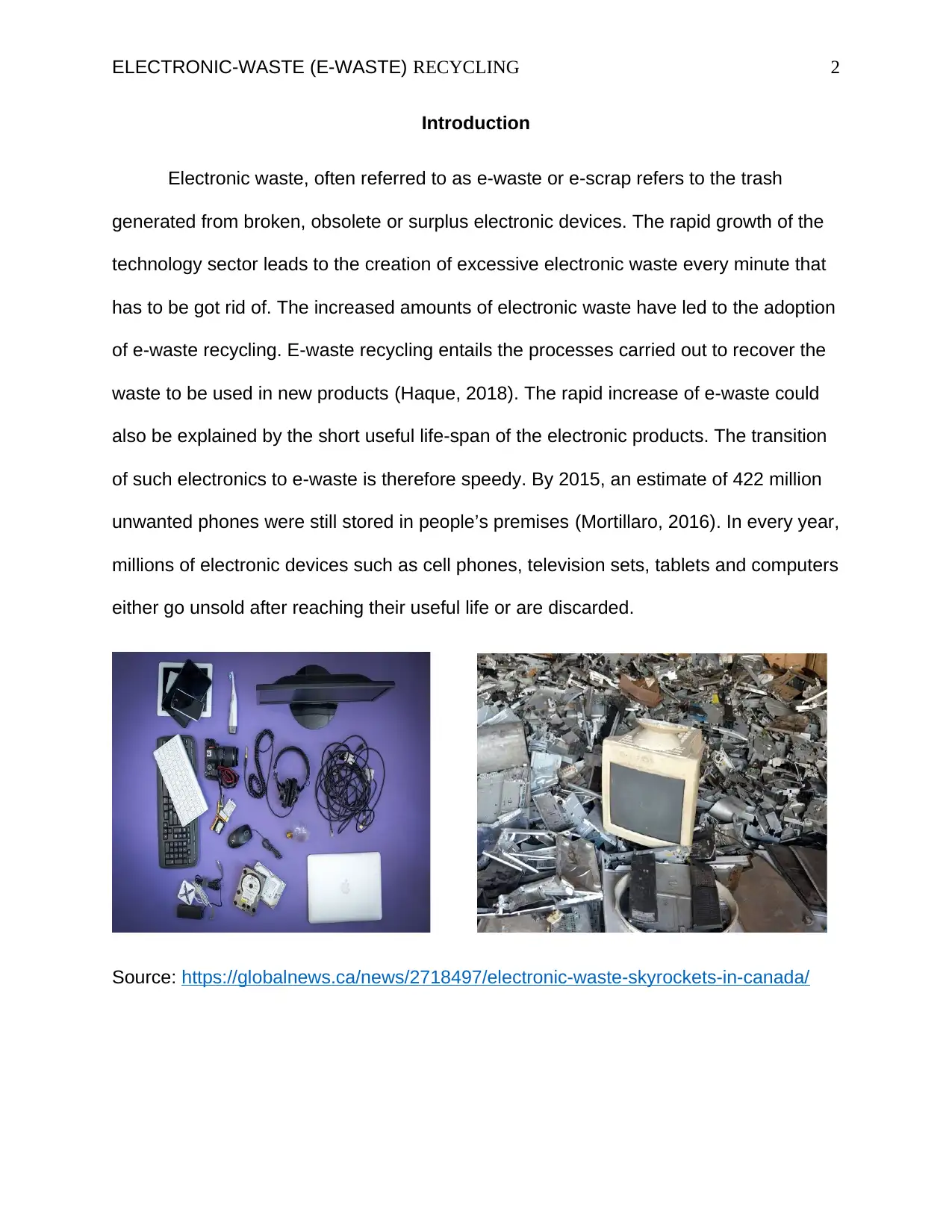
ELECTRONIC-WASTE (E-WASTE) RECYCLING 2
Introduction
Electronic waste, often referred to as e-waste or e-scrap refers to the trash
generated from broken, obsolete or surplus electronic devices. The rapid growth of the
technology sector leads to the creation of excessive electronic waste every minute that
has to be got rid of. The increased amounts of electronic waste have led to the adoption
of e-waste recycling. E-waste recycling entails the processes carried out to recover the
waste to be used in new products (Haque, 2018). The rapid increase of e-waste could
also be explained by the short useful life-span of the electronic products. The transition
of such electronics to e-waste is therefore speedy. By 2015, an estimate of 422 million
unwanted phones were still stored in people’s premises (Mortillaro, 2016). In every year,
millions of electronic devices such as cell phones, television sets, tablets and computers
either go unsold after reaching their useful life or are discarded.
Source: https://globalnews.ca/news/2718497/electronic-waste-skyrockets-in-canada/
Introduction
Electronic waste, often referred to as e-waste or e-scrap refers to the trash
generated from broken, obsolete or surplus electronic devices. The rapid growth of the
technology sector leads to the creation of excessive electronic waste every minute that
has to be got rid of. The increased amounts of electronic waste have led to the adoption
of e-waste recycling. E-waste recycling entails the processes carried out to recover the
waste to be used in new products (Haque, 2018). The rapid increase of e-waste could
also be explained by the short useful life-span of the electronic products. The transition
of such electronics to e-waste is therefore speedy. By 2015, an estimate of 422 million
unwanted phones were still stored in people’s premises (Mortillaro, 2016). In every year,
millions of electronic devices such as cell phones, television sets, tablets and computers
either go unsold after reaching their useful life or are discarded.
Source: https://globalnews.ca/news/2718497/electronic-waste-skyrockets-in-canada/
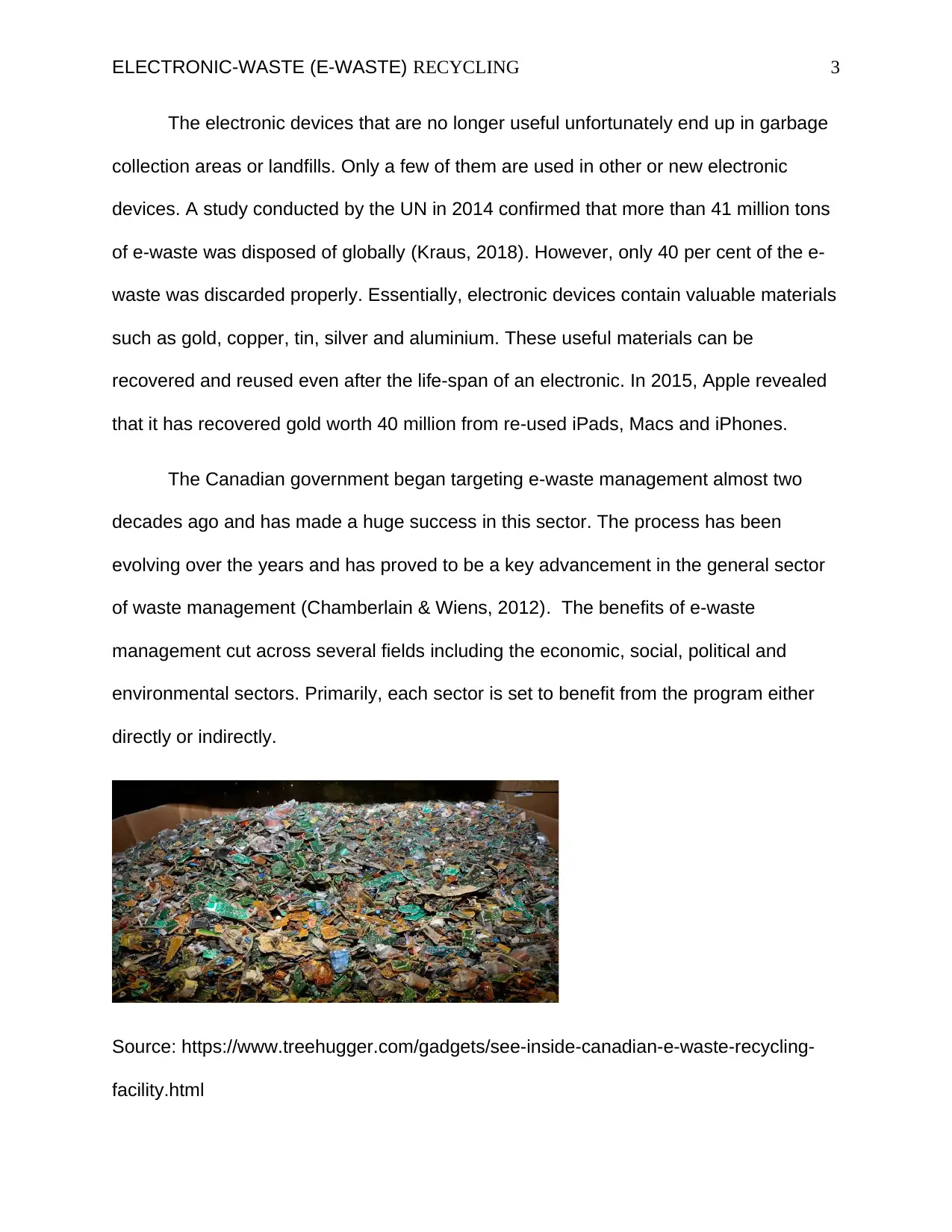
ELECTRONIC-WASTE (E-WASTE) RECYCLING 3
The electronic devices that are no longer useful unfortunately end up in garbage
collection areas or landfills. Only a few of them are used in other or new electronic
devices. A study conducted by the UN in 2014 confirmed that more than 41 million tons
of e-waste was disposed of globally (Kraus, 2018). However, only 40 per cent of the e-
waste was discarded properly. Essentially, electronic devices contain valuable materials
such as gold, copper, tin, silver and aluminium. These useful materials can be
recovered and reused even after the life-span of an electronic. In 2015, Apple revealed
that it has recovered gold worth 40 million from re-used iPads, Macs and iPhones.
The Canadian government began targeting e-waste management almost two
decades ago and has made a huge success in this sector. The process has been
evolving over the years and has proved to be a key advancement in the general sector
of waste management (Chamberlain & Wiens, 2012). The benefits of e-waste
management cut across several fields including the economic, social, political and
environmental sectors. Primarily, each sector is set to benefit from the program either
directly or indirectly.
Source: https://www.treehugger.com/gadgets/see-inside-canadian-e-waste-recycling-
facility.html
The electronic devices that are no longer useful unfortunately end up in garbage
collection areas or landfills. Only a few of them are used in other or new electronic
devices. A study conducted by the UN in 2014 confirmed that more than 41 million tons
of e-waste was disposed of globally (Kraus, 2018). However, only 40 per cent of the e-
waste was discarded properly. Essentially, electronic devices contain valuable materials
such as gold, copper, tin, silver and aluminium. These useful materials can be
recovered and reused even after the life-span of an electronic. In 2015, Apple revealed
that it has recovered gold worth 40 million from re-used iPads, Macs and iPhones.
The Canadian government began targeting e-waste management almost two
decades ago and has made a huge success in this sector. The process has been
evolving over the years and has proved to be a key advancement in the general sector
of waste management (Chamberlain & Wiens, 2012). The benefits of e-waste
management cut across several fields including the economic, social, political and
environmental sectors. Primarily, each sector is set to benefit from the program either
directly or indirectly.
Source: https://www.treehugger.com/gadgets/see-inside-canadian-e-waste-recycling-
facility.html
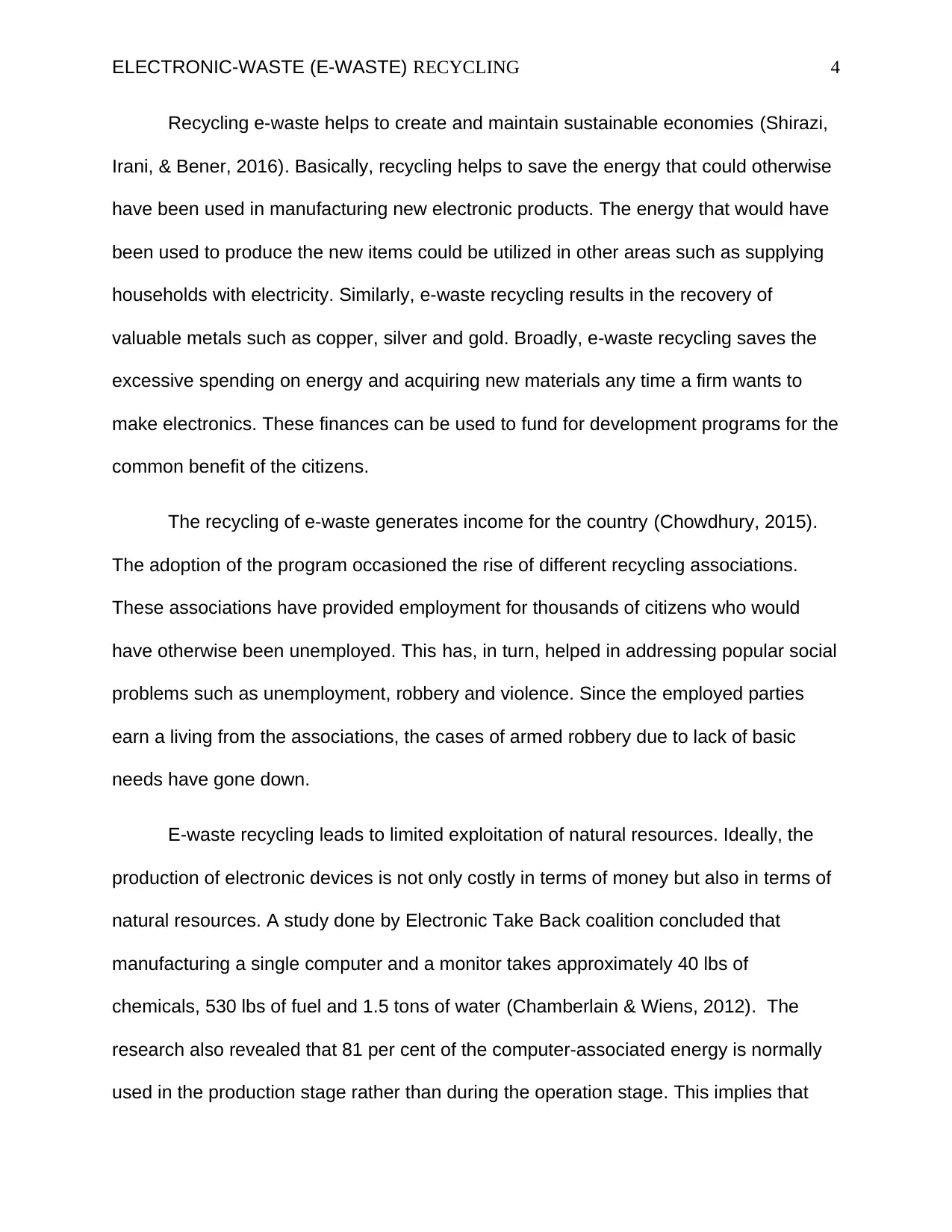
ELECTRONIC-WASTE (E-WASTE) RECYCLING 4
Recycling e-waste helps to create and maintain sustainable economies (Shirazi,
Irani, & Bener, 2016). Basically, recycling helps to save the energy that could otherwise
have been used in manufacturing new electronic products. The energy that would have
been used to produce the new items could be utilized in other areas such as supplying
households with electricity. Similarly, e-waste recycling results in the recovery of
valuable metals such as copper, silver and gold. Broadly, e-waste recycling saves the
excessive spending on energy and acquiring new materials any time a firm wants to
make electronics. These finances can be used to fund for development programs for the
common benefit of the citizens.
The recycling of e-waste generates income for the country (Chowdhury, 2015).
The adoption of the program occasioned the rise of different recycling associations.
These associations have provided employment for thousands of citizens who would
have otherwise been unemployed. This has, in turn, helped in addressing popular social
problems such as unemployment, robbery and violence. Since the employed parties
earn a living from the associations, the cases of armed robbery due to lack of basic
needs have gone down.
E-waste recycling leads to limited exploitation of natural resources. Ideally, the
production of electronic devices is not only costly in terms of money but also in terms of
natural resources. A study done by Electronic Take Back coalition concluded that
manufacturing a single computer and a monitor takes approximately 40 lbs of
chemicals, 530 lbs of fuel and 1.5 tons of water (Chamberlain & Wiens, 2012). The
research also revealed that 81 per cent of the computer-associated energy is normally
used in the production stage rather than during the operation stage. This implies that
Recycling e-waste helps to create and maintain sustainable economies (Shirazi,
Irani, & Bener, 2016). Basically, recycling helps to save the energy that could otherwise
have been used in manufacturing new electronic products. The energy that would have
been used to produce the new items could be utilized in other areas such as supplying
households with electricity. Similarly, e-waste recycling results in the recovery of
valuable metals such as copper, silver and gold. Broadly, e-waste recycling saves the
excessive spending on energy and acquiring new materials any time a firm wants to
make electronics. These finances can be used to fund for development programs for the
common benefit of the citizens.
The recycling of e-waste generates income for the country (Chowdhury, 2015).
The adoption of the program occasioned the rise of different recycling associations.
These associations have provided employment for thousands of citizens who would
have otherwise been unemployed. This has, in turn, helped in addressing popular social
problems such as unemployment, robbery and violence. Since the employed parties
earn a living from the associations, the cases of armed robbery due to lack of basic
needs have gone down.
E-waste recycling leads to limited exploitation of natural resources. Ideally, the
production of electronic devices is not only costly in terms of money but also in terms of
natural resources. A study done by Electronic Take Back coalition concluded that
manufacturing a single computer and a monitor takes approximately 40 lbs of
chemicals, 530 lbs of fuel and 1.5 tons of water (Chamberlain & Wiens, 2012). The
research also revealed that 81 per cent of the computer-associated energy is normally
used in the production stage rather than during the operation stage. This implies that
Secure Best Marks with AI Grader
Need help grading? Try our AI Grader for instant feedback on your assignments.
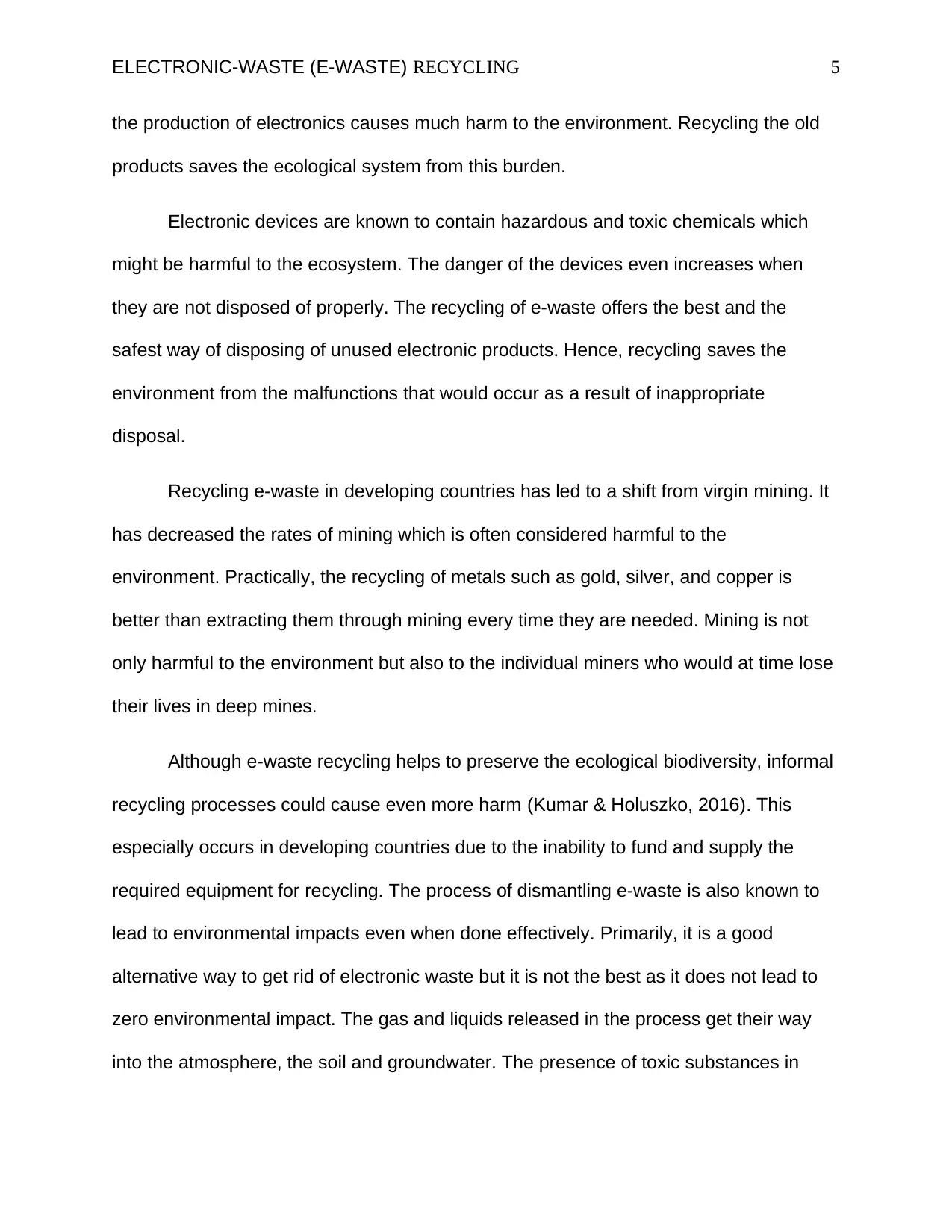
ELECTRONIC-WASTE (E-WASTE) RECYCLING 5
the production of electronics causes much harm to the environment. Recycling the old
products saves the ecological system from this burden.
Electronic devices are known to contain hazardous and toxic chemicals which
might be harmful to the ecosystem. The danger of the devices even increases when
they are not disposed of properly. The recycling of e-waste offers the best and the
safest way of disposing of unused electronic products. Hence, recycling saves the
environment from the malfunctions that would occur as a result of inappropriate
disposal.
Recycling e-waste in developing countries has led to a shift from virgin mining. It
has decreased the rates of mining which is often considered harmful to the
environment. Practically, the recycling of metals such as gold, silver, and copper is
better than extracting them through mining every time they are needed. Mining is not
only harmful to the environment but also to the individual miners who would at time lose
their lives in deep mines.
Although e-waste recycling helps to preserve the ecological biodiversity, informal
recycling processes could cause even more harm (Kumar & Holuszko, 2016). This
especially occurs in developing countries due to the inability to fund and supply the
required equipment for recycling. The process of dismantling e-waste is also known to
lead to environmental impacts even when done effectively. Primarily, it is a good
alternative way to get rid of electronic waste but it is not the best as it does not lead to
zero environmental impact. The gas and liquids released in the process get their way
into the atmosphere, the soil and groundwater. The presence of toxic substances in
the production of electronics causes much harm to the environment. Recycling the old
products saves the ecological system from this burden.
Electronic devices are known to contain hazardous and toxic chemicals which
might be harmful to the ecosystem. The danger of the devices even increases when
they are not disposed of properly. The recycling of e-waste offers the best and the
safest way of disposing of unused electronic products. Hence, recycling saves the
environment from the malfunctions that would occur as a result of inappropriate
disposal.
Recycling e-waste in developing countries has led to a shift from virgin mining. It
has decreased the rates of mining which is often considered harmful to the
environment. Practically, the recycling of metals such as gold, silver, and copper is
better than extracting them through mining every time they are needed. Mining is not
only harmful to the environment but also to the individual miners who would at time lose
their lives in deep mines.
Although e-waste recycling helps to preserve the ecological biodiversity, informal
recycling processes could cause even more harm (Kumar & Holuszko, 2016). This
especially occurs in developing countries due to the inability to fund and supply the
required equipment for recycling. The process of dismantling e-waste is also known to
lead to environmental impacts even when done effectively. Primarily, it is a good
alternative way to get rid of electronic waste but it is not the best as it does not lead to
zero environmental impact. The gas and liquids released in the process get their way
into the atmosphere, the soil and groundwater. The presence of toxic substances in
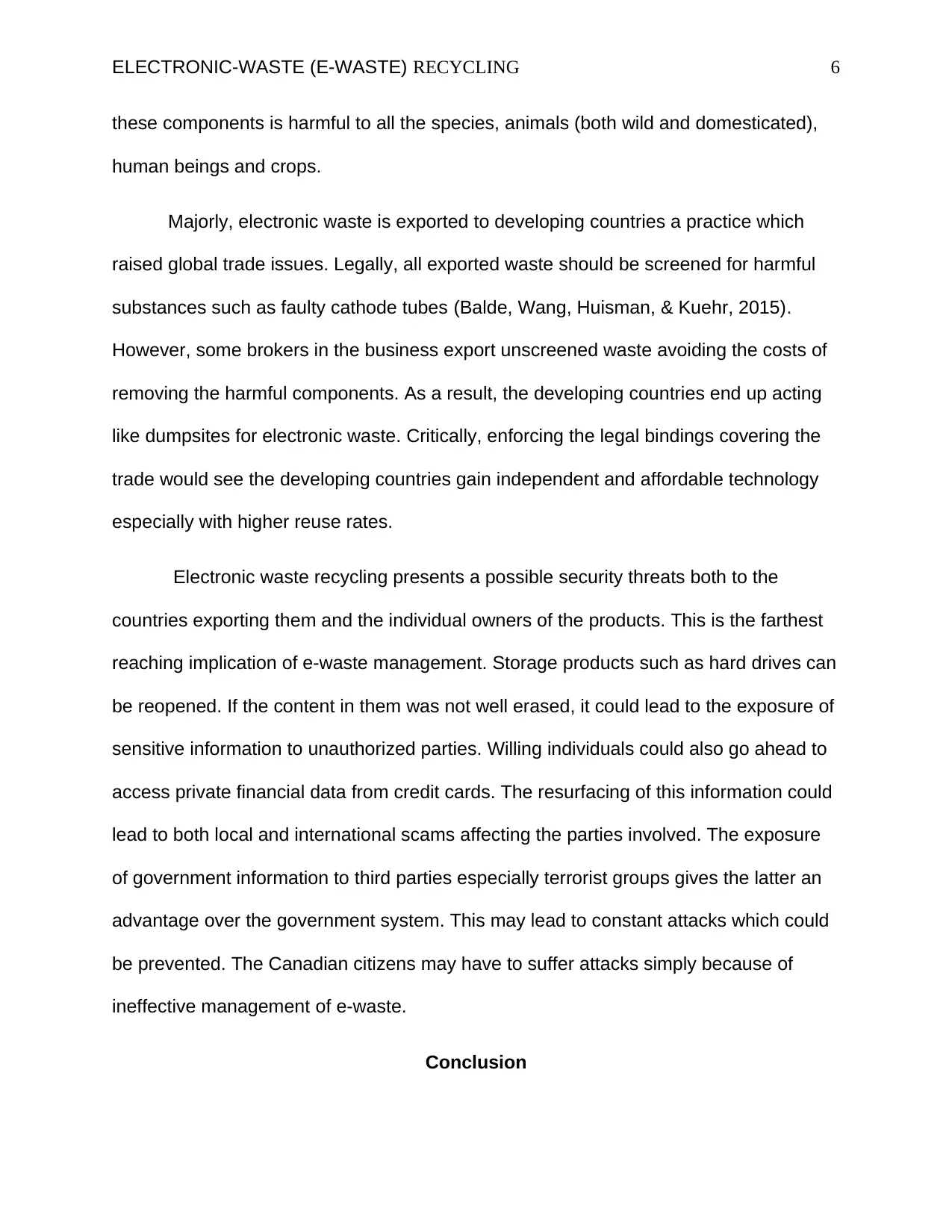
ELECTRONIC-WASTE (E-WASTE) RECYCLING 6
these components is harmful to all the species, animals (both wild and domesticated),
human beings and crops.
Majorly, electronic waste is exported to developing countries a practice which
raised global trade issues. Legally, all exported waste should be screened for harmful
substances such as faulty cathode tubes (Balde, Wang, Huisman, & Kuehr, 2015).
However, some brokers in the business export unscreened waste avoiding the costs of
removing the harmful components. As a result, the developing countries end up acting
like dumpsites for electronic waste. Critically, enforcing the legal bindings covering the
trade would see the developing countries gain independent and affordable technology
especially with higher reuse rates.
Electronic waste recycling presents a possible security threats both to the
countries exporting them and the individual owners of the products. This is the farthest
reaching implication of e-waste management. Storage products such as hard drives can
be reopened. If the content in them was not well erased, it could lead to the exposure of
sensitive information to unauthorized parties. Willing individuals could also go ahead to
access private financial data from credit cards. The resurfacing of this information could
lead to both local and international scams affecting the parties involved. The exposure
of government information to third parties especially terrorist groups gives the latter an
advantage over the government system. This may lead to constant attacks which could
be prevented. The Canadian citizens may have to suffer attacks simply because of
ineffective management of e-waste.
Conclusion
these components is harmful to all the species, animals (both wild and domesticated),
human beings and crops.
Majorly, electronic waste is exported to developing countries a practice which
raised global trade issues. Legally, all exported waste should be screened for harmful
substances such as faulty cathode tubes (Balde, Wang, Huisman, & Kuehr, 2015).
However, some brokers in the business export unscreened waste avoiding the costs of
removing the harmful components. As a result, the developing countries end up acting
like dumpsites for electronic waste. Critically, enforcing the legal bindings covering the
trade would see the developing countries gain independent and affordable technology
especially with higher reuse rates.
Electronic waste recycling presents a possible security threats both to the
countries exporting them and the individual owners of the products. This is the farthest
reaching implication of e-waste management. Storage products such as hard drives can
be reopened. If the content in them was not well erased, it could lead to the exposure of
sensitive information to unauthorized parties. Willing individuals could also go ahead to
access private financial data from credit cards. The resurfacing of this information could
lead to both local and international scams affecting the parties involved. The exposure
of government information to third parties especially terrorist groups gives the latter an
advantage over the government system. This may lead to constant attacks which could
be prevented. The Canadian citizens may have to suffer attacks simply because of
ineffective management of e-waste.
Conclusion
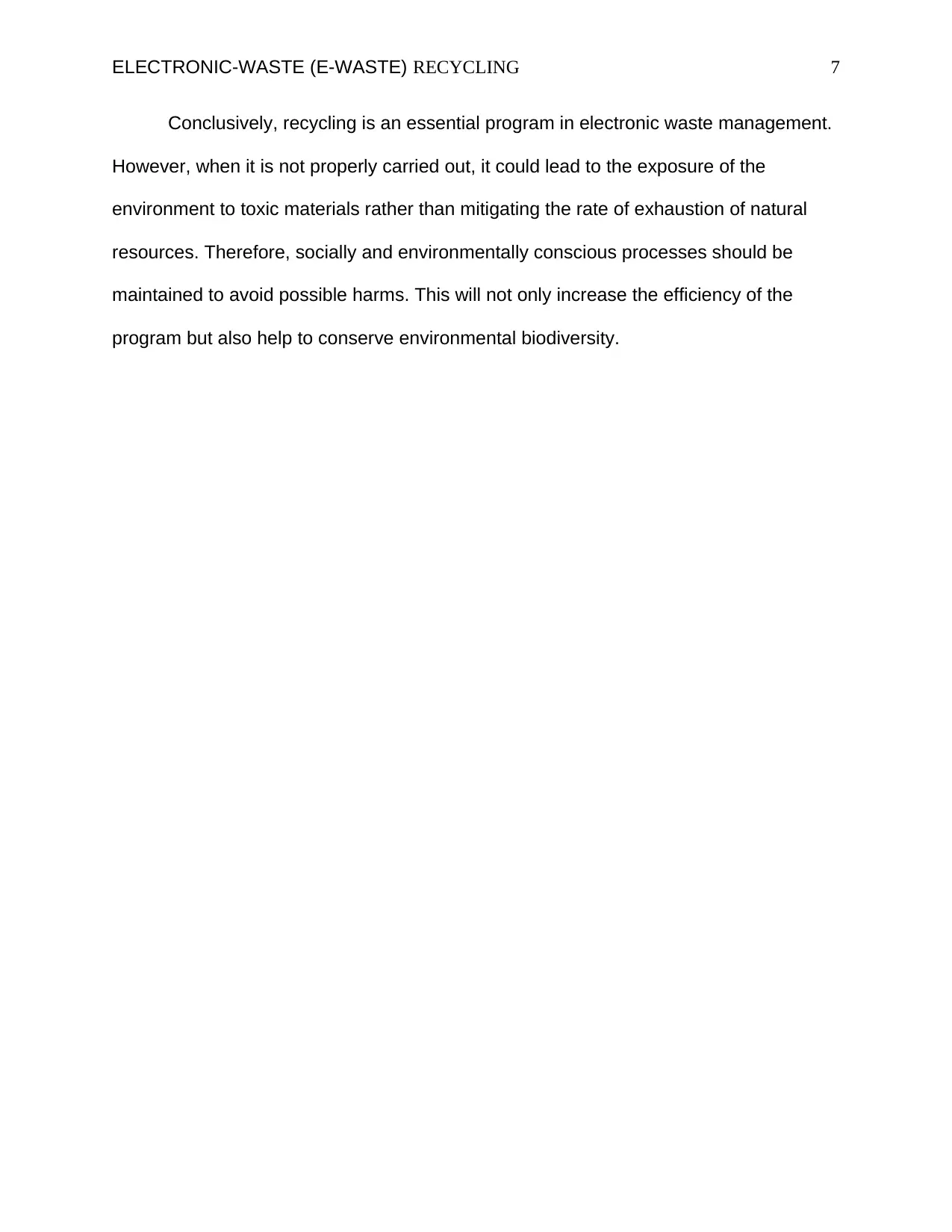
ELECTRONIC-WASTE (E-WASTE) RECYCLING 7
Conclusively, recycling is an essential program in electronic waste management.
However, when it is not properly carried out, it could lead to the exposure of the
environment to toxic materials rather than mitigating the rate of exhaustion of natural
resources. Therefore, socially and environmentally conscious processes should be
maintained to avoid possible harms. This will not only increase the efficiency of the
program but also help to conserve environmental biodiversity.
Conclusively, recycling is an essential program in electronic waste management.
However, when it is not properly carried out, it could lead to the exposure of the
environment to toxic materials rather than mitigating the rate of exhaustion of natural
resources. Therefore, socially and environmentally conscious processes should be
maintained to avoid possible harms. This will not only increase the efficiency of the
program but also help to conserve environmental biodiversity.
Paraphrase This Document
Need a fresh take? Get an instant paraphrase of this document with our AI Paraphraser
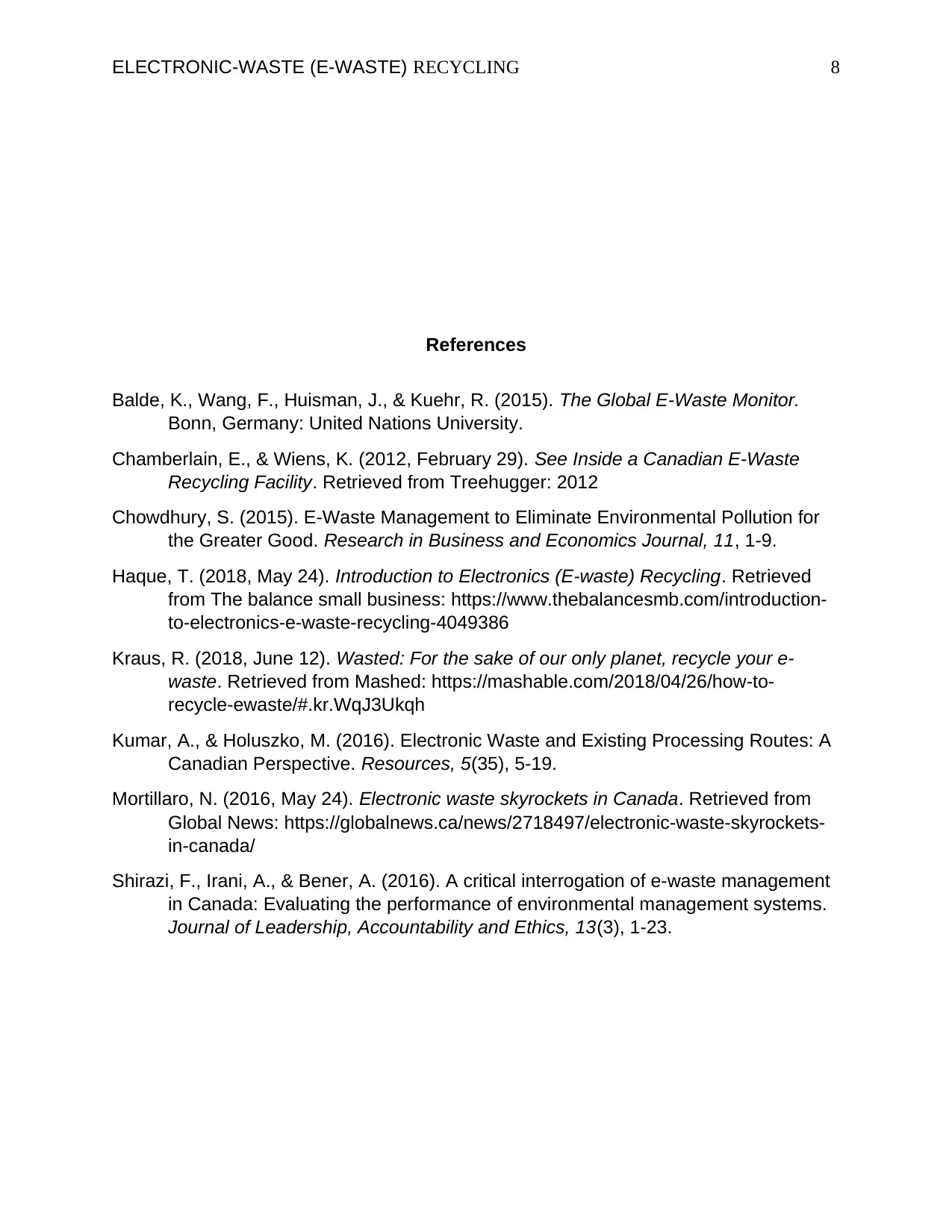
ELECTRONIC-WASTE (E-WASTE) RECYCLING 8
References
Balde, K., Wang, F., Huisman, J., & Kuehr, R. (2015). The Global E-Waste Monitor.
Bonn, Germany: United Nations University.
Chamberlain, E., & Wiens, K. (2012, February 29). See Inside a Canadian E-Waste
Recycling Facility. Retrieved from Treehugger: 2012
Chowdhury, S. (2015). E-Waste Management to Eliminate Environmental Pollution for
the Greater Good. Research in Business and Economics Journal, 11, 1-9.
Haque, T. (2018, May 24). Introduction to Electronics (E-waste) Recycling. Retrieved
from The balance small business: https://www.thebalancesmb.com/introduction-
to-electronics-e-waste-recycling-4049386
Kraus, R. (2018, June 12). Wasted: For the sake of our only planet, recycle your e-
waste. Retrieved from Mashed: https://mashable.com/2018/04/26/how-to-
recycle-ewaste/#.kr.WqJ3Ukqh
Kumar, A., & Holuszko, M. (2016). Electronic Waste and Existing Processing Routes: A
Canadian Perspective. Resources, 5(35), 5-19.
Mortillaro, N. (2016, May 24). Electronic waste skyrockets in Canada. Retrieved from
Global News: https://globalnews.ca/news/2718497/electronic-waste-skyrockets-
in-canada/
Shirazi, F., Irani, A., & Bener, A. (2016). A critical interrogation of e-waste management
in Canada: Evaluating the performance of environmental management systems.
Journal of Leadership, Accountability and Ethics, 13(3), 1-23.
References
Balde, K., Wang, F., Huisman, J., & Kuehr, R. (2015). The Global E-Waste Monitor.
Bonn, Germany: United Nations University.
Chamberlain, E., & Wiens, K. (2012, February 29). See Inside a Canadian E-Waste
Recycling Facility. Retrieved from Treehugger: 2012
Chowdhury, S. (2015). E-Waste Management to Eliminate Environmental Pollution for
the Greater Good. Research in Business and Economics Journal, 11, 1-9.
Haque, T. (2018, May 24). Introduction to Electronics (E-waste) Recycling. Retrieved
from The balance small business: https://www.thebalancesmb.com/introduction-
to-electronics-e-waste-recycling-4049386
Kraus, R. (2018, June 12). Wasted: For the sake of our only planet, recycle your e-
waste. Retrieved from Mashed: https://mashable.com/2018/04/26/how-to-
recycle-ewaste/#.kr.WqJ3Ukqh
Kumar, A., & Holuszko, M. (2016). Electronic Waste and Existing Processing Routes: A
Canadian Perspective. Resources, 5(35), 5-19.
Mortillaro, N. (2016, May 24). Electronic waste skyrockets in Canada. Retrieved from
Global News: https://globalnews.ca/news/2718497/electronic-waste-skyrockets-
in-canada/
Shirazi, F., Irani, A., & Bener, A. (2016). A critical interrogation of e-waste management
in Canada: Evaluating the performance of environmental management systems.
Journal of Leadership, Accountability and Ethics, 13(3), 1-23.
1 out of 8
Related Documents
Your All-in-One AI-Powered Toolkit for Academic Success.
+13062052269
info@desklib.com
Available 24*7 on WhatsApp / Email
![[object Object]](/_next/static/media/star-bottom.7253800d.svg)
Unlock your academic potential
© 2024 | Zucol Services PVT LTD | All rights reserved.





